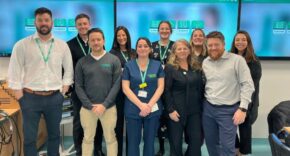
The Royal Wolverhampton NHS Trust delivers ‘SafeHands’ Quality of Care Programme utilising TeleTracking Technology
The Royal Wolverhampton NHS Trust (RWT) is the largest acute, community and primary care providers in the West Midlands, employing over 9,400 staff covering 350+ roles and providing care across three hospital sites (New Cross, Cannock Chase and West Park) as well as a variety of community and primary care sites.
In 2015, the Trust faced three major challenges: Access to Care; Patient Flow; and Infection Prevention. Faced with this, RWT focused on how a sustainable IT-enabled transformation could make the hospital more efficient whilst providing better quality care.
Building on an electronic hand hygiene monitoring solution it had implemented, supported by TeleTracking’s Real Time Locating System (RTLS) based patient flow and healthcare operations technology, RWT set out to address these three major challenges.
The ‘SafeHands’ Programme was initiated with the purpose of improving the quality of care, improving the patient experience.
The Vision
The objectives of the Programme crystallised into:
- Improved patient throughput, access, discharge planning, quality and safety.
- Redesigned functions and processes of the Trust’s ‘Patient Flow’ team to achieve greater efficiency through access to a 24/7 live bed state.
- Automated workflows to remove the burden of administrative tasks from frontline staff.
- Staff provided with real-time alerts to patient safety risks, isolation area alarms and patient walkout alarms, with a tool for escalation of staff safety concerns.
- Monitoring of all staff-patient-asset interactions for internal infection prevention and tracing and care hours per day.
As the program developed from its initial focus on hand hygiene monitoring to implement TeleTracking’s Hospital Coordination Centre and IQ Operations platform, RWT established three core best practices:
ACCESS: providing an opportunity for patients to have access to consistent, quality care that the Trust offers to the community.
EFFICIENT AND EFFECTIVE PATIENT PLACEMENT: ensuring that patients are being placed in a timely way into the care setting that best meets their medical needs.
IDENTIFICATION OF THROUGHPUT BARRIERS: identifying the barriers to daily throughput and partnering with care management to solve them.
The Partnership
The Coordination Centre is now responsible for coordinating all patient placements within the Trust. Today, 4,000 employees, all inpatients and over 1,500 assets at New Cross Hospital are equipped with RTLS sensor badges, making this the world’s largest deployment of RTLS technology in a healthcare setting.
Acting as the ‘Care Traffic Control’ centre of the Trust, staff now have real-time visibility of all beds, patients, staff and equipment across the organisation. The technology also automates workflows and provides contextual communication to support end-to-end operational improvement and sustainability.
The Trust engaged with the implementation process by allocating key members of staff to attend design sessions to focus upon agreeing improved workflows that were then incorporated into the design and build of the systems.
Working with TeleTracking, the ‘SafeHands’ partnership project team was supported to design and deliver end user training, ensuring that the key benefits of the programme were understood by all staff. In addition, all staff were supported to understand how their engagement and use of the system would drive the realisation of these benefits.
The Outcomes
The key benefits of the ‘SafeHands’ initiative to date have been measured as follows:
- Bed turn-around time has improved by 1.5 hours per discharge.
- 190 hours per week of nursing time have been returned to care.
- 56% reduction in ED 4-hour breaches due to bed availability.
- 70% of patients have a discharge time identified on the day prior.
- Medical outliers occupying surgical beds have fallen by 48%.
- The time to assign a bed to an incoming patient has fallen by 40%.
- 78% reduction in the on the day cancellation of surgery due to bed unavailability45% reduction in escalation ward capacity.
- 11% reduction in length of stay.
The system enables the Trust to track staff-to-patient contact time, which can support rota planning and help redeploy staff in line with patient acuity. These advanced analytics also help to report on the care hours per patient day, as highlighted in the Carter report, and gives staff the ability to more directly implement and report on the SAFER patient flow bundle.
Value
The data collected from a small number of UK Hospitals that have taken steps to tackle the issue, suggests that idle bed time (the time between patients using an inpatient bed), can be on average six to eight hours within every 24-hour period. Best practice would suggest it is possible to reduce this to less than two hours. This would unlock at least one ward of additional capacity per district general hospital in the NHS. There are 152 acute hospitals in the NHS. It is estimated that each NHS Trust could avoid the current £2million to £7million a year spent on providing temporary beds and wards if it embraced real-time patient flow solutions and tracked idle bed time.
This reduction in idle bed time at RWT has resulted in significant benefits accruing to the Trust, including:
RWT has not required an additional winter capacity ward to manage increased demand since implementing TeleTracking in 2015. For eight years prior to this, an additional ward had been opened to cope with winter pressures.
The 78% reduction in on-the-day cancellations of surgery due to lack of bed capacity has enabled the Trust to maintain surgical activity at planned levels when neighbouring Trusts have had to restrict activity due to winter pressures. This ensures that patient waiting times are not adversely compromised and the Trust maintains surgical income without recourse to outsourcing activity or additional (high cost) sessions.
The reduction in medical outliers by 48%, whilst supporting a reduction in on-the-day surgical cancellations, also supports a reduced length of stay for patients. By ensuring that patients are admitted to the most medically appropriate bed, first time, RWT can ensure that post-admission moves (which increase length of stay, adversely impact on the patient experience and delay care delivery) are avoided, and patient outcomes improve.
By supporting an 11% reduction in the average length of stay across the Trust, RWT has benefited from increased capacity, without having to invest in bricks and mortar. Patients have benefitted from reduced exposure to healthcare associated infections (HCAIs), and the cost of delivering care has been reduced.
Gwen Nuttall, Chief Operating Officer, states: “TeleTracking has a great impact on not just quality of patient care, but efficiency. With better patient flow in the system and less delays, we have a more efficient service, and more efficiency means better use of money. We link it closely to the length of stay and how we can reduce this, and knowing when patients are ready for discharge, which also delivers efficiency.”











